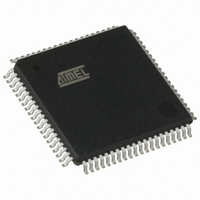AT89C5132-ROTUL Atmel, AT89C5132-ROTUL Datasheet - Page 49

AT89C5132-ROTUL
Manufacturer Part Number
AT89C5132-ROTUL
Description
IC 8051 MCU FLASH 64K USB 80TQFP
Manufacturer
Atmel
Series
AT89C513xr
Specifications of AT89C5132-ROTUL
Core Processor
C52X2
Core Size
8-Bit
Speed
20MHz
Connectivity
IDE/ATAPI, I²C, MMC, PCM, SPI, UART/USART, USB
Peripherals
I²S, POR, WDT
Number Of I /o
44
Program Memory Size
64KB (64K x 8)
Program Memory Type
FLASH
Eeprom Size
4K x 8
Ram Size
2.25K x 8
Voltage - Supply (vcc/vdd)
2.7 V ~ 3.3 V
Data Converters
A/D 2x10b
Oscillator Type
Internal
Operating Temperature
-40°C ~ 85°C
Package / Case
80-TQFP, 80-VQFP
Cpu Family
89C
Device Core
8051
Device Core Size
8b
Frequency (max)
40MHz
Interface Type
IDE/SPI/UART/USB
Total Internal Ram Size
2.25KB
# I/os (max)
44
Number Of Timers - General Purpose
2
Operating Supply Voltage (typ)
3V
Operating Supply Voltage (max)
3.3V
Operating Supply Voltage (min)
2.7V
On-chip Adc
2-chx10-bit
Instruction Set Architecture
CISC
Operating Temp Range
-40C to 85C
Operating Temperature Classification
Industrial
Mounting
Surface Mount
Pin Count
80
Package Type
TQFP
Package
80TQFP
Family Name
89C
Maximum Speed
40 MHz
Operating Supply Voltage
3 V
Data Bus Width
8 Bit
Number Of Programmable I/os
44
Number Of Timers
2
Maximum Clock Frequency
20 MHz
Data Ram Size
2304 B
Mounting Style
SMD/SMT
A/d Bit Size
10 bit
A/d Channels Available
2
Height
1.45 mm
Length
14.1 mm
Maximum Operating Temperature
+ 85 C
Minimum Operating Temperature
- 40 C
Supply Voltage (max)
3.3 V
Supply Voltage (min)
2.7 V
Width
14.1 mm
For Use With
AT89OCD-01 - USB EMULATOR FOR AT8XC51 MCU
Lead Free Status / RoHS Status
Lead free / RoHS Compliant
Available stocks
Company
Part Number
Manufacturer
Quantity
Price
12. Timers/Counters
12.1
12.2
4173E–USB–09/07
Timer/Counter Operations
Timer Clock Controller
The AT89C5132 implement two general-purpose, 16-bit Timers/Counters. They are identified as
Timer 0 and Timer 1, and can be independently configured to operate in a variety of modes as a
Timer or as an event Counter. When operating as a Timer, the Timer/Counter runs for a pro-
grammed length of time, then issues an interrupt request. When operating as a Counter, the
Timer/Counter counts negative transitions on an external pin. After a preset number of counts,
the Counter issues an interrupt request.
The various operating modes of each Timer/Counter are described in the following sections.
For instance, a basic operation is Timer registers THx and TLx (x = 0, 1) connected in cascade
to form a 16-bit Timer. Setting the run control bit (TRx) in TCON register (see Table 40) turns the
Timer on by allowing the selected input to increment TLx. When TLx overflows it increments
THx; when THx overflows it sets the Timer overflow flag (TFx) in TCON register. Setting the TRx
does not clear the THx and TLx Timer registers. Timer registers can be accessed to obtain the
current count or to enter preset values. They can be read at any time but TRx bit must be
cleared to preset their values, otherwise the behavior of the Timer/Counter is unpredictable.
The C/Tx# control bit selects Timer operation or Counter operation by selecting the divided-
down peripheral clock or external pin Tx as the source for the counted signal. TRx bit must be
cleared when changing the mode of operation, otherwise the behavior of the Timer/Counter is
unpredictable.
For Timer operation (C/Tx# = 0), the Timer register counts the divided-down peripheral clock.
The Timer register is incremented once every peripheral cycle (6 peripheral clock periods). The
Timer clock rate is F
For Counter operation (C/Tx# = 1), the Timer register counts the negative transitions on the Tx
external input pin. The external input is sampled every peripheral cycles. When the sample is
high in one cycle and low in the next one, the Counter is incremented. Since it takes 2 cycles (12
peripheral clock periods) to recognize a negative transition, the maximum count rate is F
i.e., F
cycle of the external input signal, but to ensure that a given level is sampled at least once before
it changes, it should be held for at least one full peripheral cycle.
As shown in Figure 12-1, the Timer 0 (FT0) and Timer 1 (FT1) clocks are derived from either the
peripheral clock (F
CKCON register. These clocks are issued from the Clock Controller block as detailed in Section
’CKCON Register’, page 14. When T0X2 or T1X2 bit is set, the Timer 0 or Timer 1 clock fre-
quency is fixed and equal to the oscillator clock frequency divided by 2. When cleared, the Timer
clock frequency is equal to the oscillator clock frequency divided by 2 in standard mode or to the
oscillator clock frequency in X2 mode.
OSC
/24 in standard mode or F
PER
PER
) or the oscillator clock (F
/6, i.e., F
OSC
/12 in standard mode or F
OSC
/12 in X2 mode. There are no restrictions on the duty
OSC
) depending on the T0X2 and T1X2 Bits in
OSC
/6 in X2 mode.
AT89C5132
PER
/12,
49














